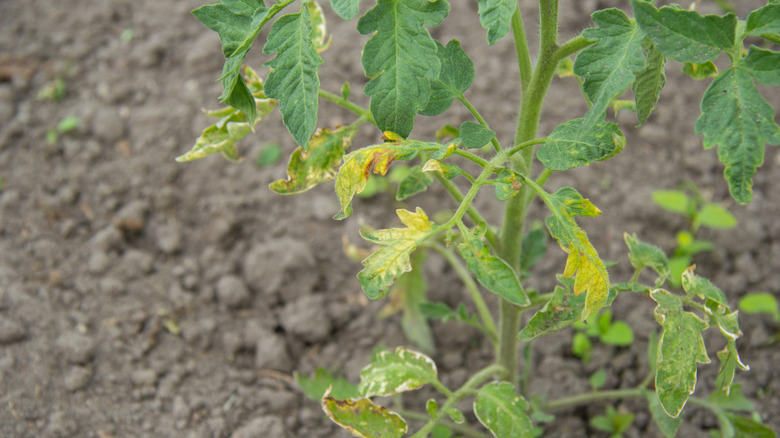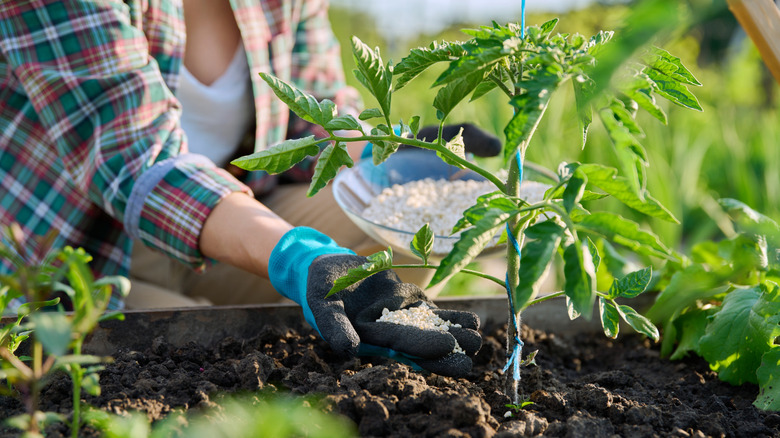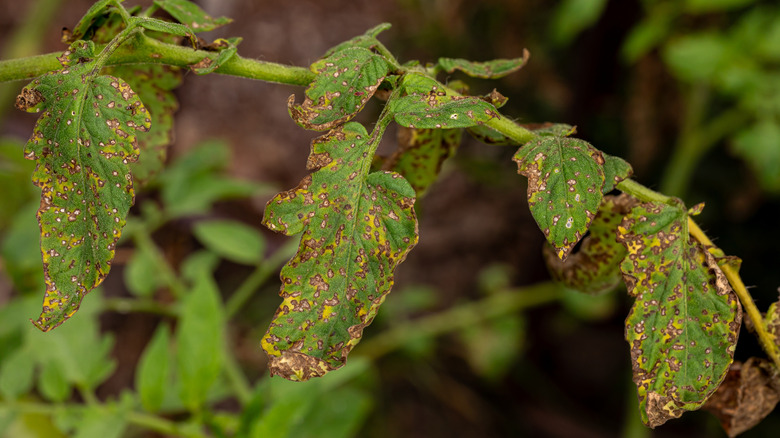What Causes Tomato Leaves To Yellow, And What You Can Do To Fix It
Tomatoes have long been a favorite among amateur and seasoned gardeners. They are fairly easy to grow, sprout up quickly, and reward you with fruit that you can eat straight from the vine. However, you cannot be completely hands off with them. Depending on the size of the plants and variety of tomatoes, you may need to prune them for more fruit production or stake them as they grow. In addition, you should monitor them for nutrient deficiencies, pests, and fungi ... all of which can show up as chlorosis, or yellowing leaves.
If you're dealing with a nutrient deficiency, close observation of where the yellowing is occurring can clue you in on what's happening within. Plants lacking in magnesium, phosphorous, and nitrogen will develop yellow leaves among the older foliage toward the bottom of the plant. Discoloration happens more among the middle leaves when the plant needs more potassium and nitrogen. If you see yellowing among younger leaves higher up in the plant, you're likely dealing with deficiencies in iron, calcium, and manganese.
Yellowing that begins as spots or take on a circular shape are more indicative of garden fungus. Common fungal diseases that affect tomatoes result from spores already living in the soil or in plants that were previously grown in that spot. Paying attention to symptoms of these diseases — and ensuring that your tomatoes have their ideal growing conditions — can turn your plant's health around easily.
Treating nutrient deficiencies in tomato plants
Common nutrient deficiencies in tomato plants are: nitrogen, phosphorous, potassium, magnesium, manganese, and iron. In addition to turning leaves yellow, these deficiencies can discolor fruit, stunt plants, or hinder ripening. One of the best ways to avoid these issues is to know what makes a tomato plant happy. For starters, make sure the soil is well-draining, rich in organic matter, and has a pH between 6.2 and 6.8. Conducting a soil test will give you valuable insight to these needs.
Fertilization also is key, but gardeners need to be mindful of the effect of fertilizer on plant growth. Also, tomatoes can be finicky about the dosage and timing. Before planting anything, work in a fertilizer that is low in nitrogen, high in phosphorous, and medium-high in potassium. If the fertilizer is too high in nitrogen early on, the plant itself will grow well, but the development of the fruit may be impeded. The fruit will benefit from nitrogen once the tomatoes are about one-third of the way through their growth. Mix about 1 tablespoon of calcium nitrate per tomato plant into the top inch of soil and then water thoroughly. Repeat this about two weeks after your first harvest, and then a month after that. If the plants are still showing signs of nutrient deficiencies, consider conducting another soil test.
Identifying and preventing fungal diseases
Septoria leaf spot, early blight, and bacterial spot are common fungal diseases that appear as spots on lower leaves. When the blemishes are left to grow, infected leaves can turn yellow before wilting and dropping off. If you see these symptoms on your plant, remove the leaves immediately and throw them away in the trash or burn them so that fungal spores don't spread to other plants. However, don't remove more than one-third of the plant's leaves. Continue this pruning practice throughout the growing season. If spores hidden in the soil don't have any low-hanging foliage to grasp onto, your plant will be less likely to get infected. A fungicide usually isn't necessary for leaf spots.
After removing the impacted leaves, work to stave off future infections. Make sure the plants stay dry and have proper air circulation. Don't crowd them — prune and stake them to keep the vines tidy and off the ground. Since fungal spores live in the soil, mulching or laying landscape fabric down around the plants will keep them from splashing upward onto leaves when watered. Also, be sure to water the base of the plant to avoid wetting the foliage because too much moisture is a breeding ground for disease.
Fungal diseases also can be minimized by caring for the planting area before you put tomatoes in. Rotating the location of your tomatoes every other year (or even every year) can improve soil quality and lower the likelihood that the planting site will harbor pests and diseases. Also, find a variety that is known for being resistant to disease like 'Brandywine,' 'Goliath Bush,' or 'Roma.'


